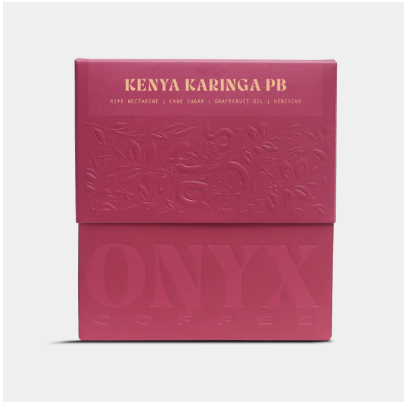
About this Coffee
Karinga Factory, founded in 1983 and boasting 500 active members, is recognized as a modest-sized cooperative and operates as an integral part of the Gitwe Farmers Cooperative Society. You’ll find this PB outturn to be near-perfectly round, a delicious product of natural genetic mutation in 11% of coffee trees.3
Established in 1983, Karinga Coffee Factory occupies a five-acre plot of land, catering to the villages of Kimaruri, Kariungu, Gachuha, and Mugalwa. Situated at an elevation of 1840 meters above sea level in the Thika District of Kiambu County, this region is traditionally known for tea cultivation. Karinga is a crucial part of the Gitwe Farmers Co-op and currently boasts approximately 500 active members.
Heading the operations are six permanent staff members, with occasional workers joining during harvest times. The affiliate members affiliated with the factory handle all agronomic aspects related to coffee production, including sourcing coffee from the Coffee Research Station and adhering to its guidelines for planting. Additionally, they are responsible for crucial fieldwork such as weeding, pruning, spraying, fertilizer application, mulching, and receiving technical advice through farmer training programs and field visits organized by the Ministry of Agriculture.
Once the coffee cherries are harvested, they are promptly delivered to the factory for further processing using the wet processing method. To facilitate this, water is pumped from River Rwabura to reservoir tanks for pulping, and environmentally conscious practices are embraced, as seen in their water recycling initiatives. In alignment with the growing awareness of environmental conservation, the factory has implemented various projects, including waste water soak pits, where water is allowed to soak back into the soil, promoting sustainability and responsible resource management.
KENYA AUCTIONS
Kenya’s coffee system is quite sophisticated, employing two primary avenues for selling and exporting coffee: the Nairobi Coffee Exchange, which operates as a central auction system, and the marketer direct-sale system. Among these, cooperatives often prefer the former, utilizing the auction system to sell their coffees based on their quality.
To participate in the competitive auction system and bid on coffees, one must be a licensed marketer. The auctions take place every Tuesday, and the previous week’s samples are sent out to the marketers and cuppers. This allows them to evaluate the coffees’ quality before deciding which ones to bid on. The term “outturn” refers to the week when the coffee is wet-milled and produced. Each of our Kenya lots is labeled with a number indicating its specific outturn. We have a preference for outturns ranging from 14 to 21, as they fall in the middle to the end of the harvest period and typically yield nutrient-rich and exceptional-tasting coffees.
KENYA PROCESS
In the Kenya process, first, the cherries are sorted, and under-ripe/overripe cherries are removed. Once the sorting is finished, the coffee is then depulped. This is done by squeezing the cherry through a screen and removing the fruit and skin from the bean. The coffee is then left to ferment in white ceramic tiled tanks for 24 hours. Next, the coffee is stirred for a short amount of time and left to ferment for another 24 hours. After two days of dry fermentation, the coffee is washed with fresh water, removing the sticky mucilage attached to the beans that are loosened by bacteria during the fermentation. It’s then soaked in water to ferment overnight slightly. The coffee goes through sorting and density channels, which separates the lots, and then it is taken to raised beds to dry. Once it reaches 11.5-12% moisture content, the coffee is brought to conditioning bins to rest until it goes to the dry mill.
Once a coffee has been processed, dried, and then milled, it goes to a sorter that separates the beans by specific characteristics, mainly size. Coffee goes into a machine that vibrates, sending beans through different screens with different-sized holes and sorts the coffee based on size and density. This results in a more uniform coffee and cup profile. Then the coffees are auctioned based on the grade (size & density) they have.
AA (screen size 17 & 18)
The largest and most celebrated grade of Kenyan coffee. Usually the highest priced coffee on the auction from each outturn and factory. AA is the most common grade we buy and what we normally expect from an outstanding Kenya cup.
AB (screen size 15 & 16)
This grade represents about 30% of Kenya production. While AB is usually considered lower quality than AA, we find that to not be accurate in the cup. Over the years of cupping, we have consistently found incredible AB’s that actually cup better than their more prestigious AA relatives, enforcing the idea that everything must be cupped and not have its value determined based on classification or reputation.
PB (Peaberry)
Peaberries represent about 10% of Kenya production. They are a result of a coffee cherry only producing one bean instead of two. Technically they are fused together during early stages and form one round bean instead of two half spheres. We tend to notice more fermentation tasting notes here. Winey, syrupy, and mouth coating are some of the attributes that we usually notice in the cup.
OTHER SIZES
E (large Peaberries & large chipped beans)
C (screen size 14 & 15)
TT (falls through 14)
T (small or broken pieces of beans)